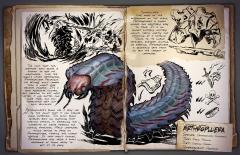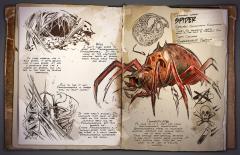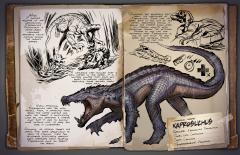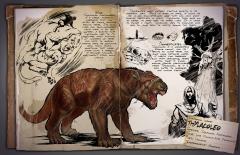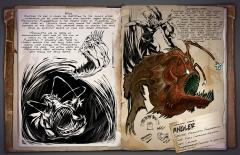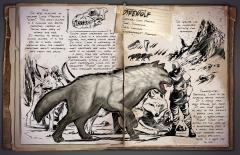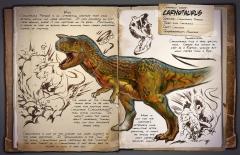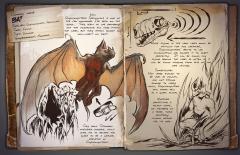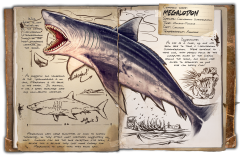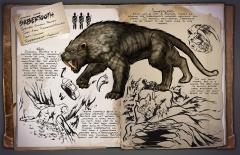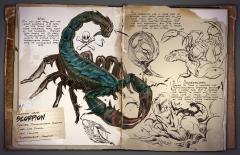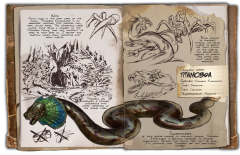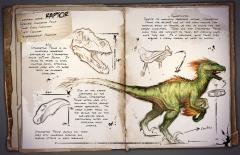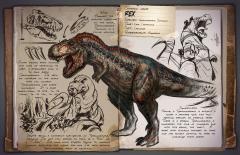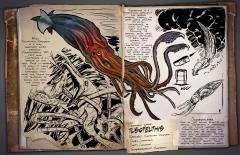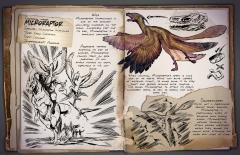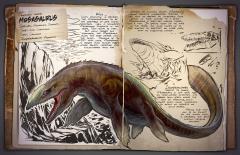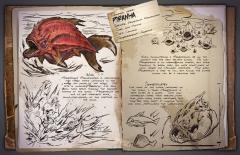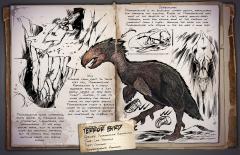Search the Community
Showing results for tags 'aggressive'.
-
Hello Brave Survivors. As there are alot of creatures in the world of ark I would love to suggest a Mythical Creature that comes from my country of New Zealand. Known as the "Taniwha" pronounced (Tah-Nee-Far). This creature is a myth to the Maori People from my country and I would love wildcard studios to add this creature to the game. Just trying my luck on here. It is a giant sea serpent which lurks in the depths of the ocean similar to abberations "Basilisk" but much more larger. It also has Maori patterns on the serpents face aswell. It can also rise to the surfaces of the ocean if it desires to choose so when untamed but prefers its home in the depths of dark waters. Can also be a stealthy behemoth when the player is unwary in the ocean, so bringing alot of tribe members with you is highly recommended. Will provide more information on this creature in the future and pictures of the creature. I know it won't make it to the game but hey worth a try 😊 Thank you survivors for taking the time to read this article and wildcard studios thank you for making such a great game despite the delays and all 😂😊 Wildcard make it happen! To all survivors out there, Tame Hard, Be The Best Tribe, Be Happy, Share Positivity, Be Kind, You are worth something, Never let anyone tell you otherwise 😊 Survivor: ILL53T K4ZZ
-
Description: The Hatzegopteryx is an extinct flying reptile that was around the same size as the Quetzal. It moves much faster than normal flyers. The shape of its head causes it to peck through smaller dinosaurs. Saddles: The Hatzegopteryx can have a saddle that has a bomber (Controlled by the person flying this beast) and a ball turret gunner (A saddle that can have 2 passengers for this to work). The ball turret can take advanced rifle bullets and the Bombs can be out of grenades. The bombs can only be used while diving and the ball turret can only be used while flying. You can also use an automated turret which does a lot less damage. It also has a water saddle which can cause it to fully submerge in water but is not that fast in water but it goes faster while flying with this saddle equipped. Abilities: It can carry up to a stego (because of the ball turret). It has an attack that pierces up to a medium dino doing something similar to stego. The Hatzegopteryx has an attack when it swing it's head around and does knockback and of course a normal peck attack doing similar damage to a rex. It cannot use the attack when it swings around its head when flying. It goes faster with the aquatic saddle because it does not have a massive saddle on it. It can also pick up to a mammoth with this saddle. Taming: The taming will not be traditional. You need to sneak up on it with meat or kibble (Takes extraordinary kibble) and feed it and try not to die because if it notices you it will pick you up and drop you. You will need more than just Gillie armor. Domesticated: You can use the gunship saddle because you've tamed it but now you have a powerhouse of a creature to use. The Aquatic saddle is also good for speed. Other: The creature cannot be taken into a boss fight and of course, cannot be taken into a cave. The ball turret will be placed under the center of the dino and the Bombs will be dropped from the back of the dino. The ball turret saddle will be very expensive but the aquatic saddle will be cheap but takes a lot of hide. Cannot be netted while using the “Gun Ship Saddle” but can be netted by the “Aquatic Saddle”. Sorry for any typos and grammar mistakes but who is excited about ASA
- 1 reply
-
- dinosaur gun ship
- aquatic saddle
-
(and 2 more)
Tagged with:
-
Bajadasaurus Dossier Species: Bajadasaurus Aquamantisia Temperament:Territorial Wild Bajadasaurus Aquamantisia is notorious for its extreme territorial behavior even to the most peaceful of creatures. Most apparent about the Bajadasaurus is that some have Sails along their neck While some have horns because of the species’ sexual dimorphism. When they're not busy running down another creature, bajadasaurus enjoy being in water spending most of their time there but travel back to the jungle when it starts to get dark out. (extra info,not in dossier) I have heard numerous stories of the infamous Bajadasaurus Aquamantisia suddenly attacking and causing great damage to villages. These creatures truly are the jack in the box! When they're not busy running down another creature, bajadasaurus enjoy being in water spending most of their time there but travel back to the jungle when it starts to get dark out. Bajadasaurus are a perfect example of sexual dimorphism; the females are less aggressive and sport 2 neck sails that they flare to frighten oncoming attackers, while the males have an array of spines on their neck. They also release a pheromone that makes them more aggressive when they inflate their neck sac. While the females of the species rarely attack unless provoked first, the males of the species are the polar opposite and even pick fights with rival males or other creatures that get too close, even herbivores! Taming Because of their less aggressive manner, before attacking female Bajadasaurs will flare their sails but will not proceed to attack if you drop them some fiber, after a while hand-feed the female to gain her trust. Although i have seen a tamed Bajadasaurus male its owner did not want to say how one might time this valuable creature. (extra info,not in dossier) It is fairly common to see two bajadasaurus males fight and while they won't kill each other, they may leave each other incredibly wounded. However, as I have seen firsthand, this is the only way that one can attempt to befriend them because of their awful temperament. During A clash between two males you must help one outbest the other and after the losing male skitters off the winning male will follow you, pondering if it needs to attack. At this time you want to feed it some medical brews to take care of those gnarly injuries. Females are much simpler to tame on the other hand, just drop them some fiber , but don’t get too close or they might become weary and attack. After a while they'll be okay with you hand feeding them. Domesticated Bajadasaurus specializes in gathering fiber and wood; however, they can crush even the hardest of stones. From quick feet to neck maneuverability, bajadasaurus are shockingly mobile for their size and become even more so after they've had a quick dip in some water. While a great mount to keep around , i'll have to continue to test how to mate bajadasaurs in captivity (extra info,not in dossier) An allied bajadasaur are excellent gatherers of fiber and wood, they can even crush the hardest of stones. These creatures are surprisingly mobile for their size and become even more so after they've had a quick dip in some water. During my studies, I've observed that these beasts simply refuse to mate while in captivity…I wonder what's their favored condition for mating. Gameplay -Can fit into the smaller boss arenas when using the toggle neck mode - Excellent swimmer -Saddle Will be placed under the head -Large Oxygen Stat -Larger than Amargasaurus but much smaller than the brontosaurus Spawns -Shallow Sea water -streams/Rivers -Jungles -Always in groups of 3 (2 females and 1 male,or 1 female and 2 males) Taming Female-get close enough to where the female will flare its sails at you then drop it some fiber. At 50% taming you can now hand feed her the fiber and this will give more percentage than just dropping it to her Male-while two males are fighting, help the male injure the other male that you do not want to tame. When it reaches 20% health it will run off. The winning male will then approach you before attacking if you do not have medical brews in your inventory.If you do have medical brews it will then lean its neck down to drink them. Breeding -For some weird reason, tamed bajadasaurudae seem to only want to mate while they're in water. -If a bajadasaurus egg is hatched while in water the baby will be granted a permanent buff called “Water Birth” that works similar to imprinting and can be stacked with it. -However, be careful to not let the baby drown before the egg hatches! Sexual dimorphism -Females lack the neck horns but are adorned with sails that can flare out before they attack or when they feel threatened, when doing this they cause a fear effect by making themselves appear larger. -Males lack the sails but instead have an array of horns protruding from the neck region. They also have a neck sac that can be inflated, causing the release of a pheromone that enrages the dino for a period of time. Passive Abilities -Pressure Dive: The deeper down in the bajadasaur goes the more damage it will do. from 1x at the surface to 1.5x at the lowest point in the ocean -Accelerates slowly while running -Hydration buff when in contact with water (similar to spino, increasing speed and damage) -filled water containers in the inventory activates the hydration buff -rain activates the hydration buff until it stops raining -A toggle neck mode allowing the creature to lower its neck to dodge projectiles or fit into places it previously could not fit into. -immobile turning Resources/Harvesting -Cannot harvest berries/seeds -only eats fiber -Great wood and fiber gatherer -can also gather fiber from trees -Organic polymer can be scraped from skin (similar to leedsichthys) -drops organic polymer when harvested -males can harvest rocks with neck spine sweep -Females can harvest rocks with stomping tantrum Behaviors -runs away from a fight when at low health (similar to spino) -at sunrise groups will leave jungles and go to rivers/lakes/shallow waters. At sunset groups will return back to the jungle -in the wild it will attack anything thats gets too close to it unless it is bigger than the bajadasaur itself or just a very small creature (this includes herbivores) -absolutely hates (tamed) amargasaurus and will always try to kill them -in the wild Females will flare its sails at a creature coming too close, only if it comes even closer then the female will charge and attack the threat -males just attack anything coming too close with no warning (unless bigger than itself or just too small) -males may may get into fighting matches where they clash horns, not killing each other but the one with its health lowered to 20% first will run off -males who just left a fight with each other will become more like the female in terms of aggression (stares down a creature coming too close, only if it comes even closer then the male will charge and attack the threat) Moveset Left click-left/right foot stomp Right click (Female)- Stomping Tantrum: Goes on hind legs then slams down Right click (Male)- Neck Spine Sweep Spacebar-Toggle Neck Mode: lowers neck down to shoulder level C -Tail grab: Can grab small creatures and players (raptor and smaller) Right click (while creature in tail)- Downward tail bash X -(female)- Bellow: sails flare out and causes a fear effect (similar to yuty) on smaller creatures and takes reduced amount of damage when attacked X -(Male)- Bellow: Neck sac becomes inflated and causes a rage effect on the dino giving it boosted speed and damage output Inspiration/idea Links Gender dimorphism based on the differing view of how bajadasaurus actually looked-Bajadasaurus - Wikipedia Aggression-Bull - Wikipedia Territorial factor,Male Sparring-Goat - Wikipedia Female flaring neck sails-Deception in animals - Wikipedia Male inflatable neck sack-Gular skin - Wikipedia
- 55 replies
-
- 2 forms
- mean sauropod
- (and 7 more)
-

Harpagornis Moorei - the stupendous slayer of the skies!
SirGlobbyLot posted a suggestion in Creature submission archive
Image at the bottom! Dang Forums making it hard to see... Dossier: “It always surprises me when I find extinct animals on the Ark that are so much larger than they should be! Such is the case with the Harpagornis Moorei, now a winged omen of death! Almost permanently flying as high as the Ark reaches, it never descends below a certain altitude and hunts anything that flies up to meet it. Get too close and the Haast Eagle, as it’s informally known, shreds its prey with those enormous talons! Anything unlucky enough to be caught will quickly bleed out, and trying to outfly that winged terror when slowed is a recipe for a grisly end. Taming the Haast Eagle takes aerial supremacy for any tribe; it must be knocked out high in the air, and a keen-eyed Survivor can look out for their nests atop mountains to signify an Eagle is high above! Tamed Harpagornis are incredible battle-mounts, capable of lifting creatures bigger than itself and tearing them apart. I’ve seen a tamed Eagle build two nests across the Ark, flying between them by command without a rider! These could be useful for long-distance transport, and their nests are so cosy that they act as a primitive incubator for eggs!” Art by the brilliant @timinybillybob - look him up on the webz! Description: So, you’re off flying round the Ark. It’s a lovely sunny day, you’re high above those Gigas, and the shield dome shimmers above. But wait, what’s that ahead? You’ve flown too high, flown too close. The Haast Eagle has spotted you, and you’re going to have to get out of there! Alright, so look, I know the Latin name was changed, but Harpagornis just sounds better. I love flying round on Ark, as it’s easily the easiest way of getting around. Aberration even blocks fliers to make it harder. But still, jump on a Pteranodon, a Quetz, fly up and the only threat is running out of stamina. Maybe a Wyvern or Argy if you nip to the loo and forget to land somewhere safe, but still, the airspace of the Ark is too comfortable. No longer! The Harpagornis was the largest recorded Eagle of all time, and was a fearsome hunter capable of taking down Giant Moa, performing strong attacks to knock its prey down. They were also similar to vultures, slurping out insides from corpses they would find. “But it sounds like an Argy!” I hear you say. Yep, it’s a big bird boi! The Harpagornis will be, literally, the sky-Giga. The deep ocean has Mosa and Squid which won’t follow you upwards, the ground has Gigas and Carchas which won’t follow you toooo far, and the sky will have the Haast Eagle, which won’t follow you down. There would only be one or two spawning at a time, similar to a Giga, due to their incredible health, damage potential, and stamina. The Eagle permanently resides in the highest parts of the Ark’s airspace, far beyond sight of those on the ground. Wild Eagles hover about the Ark as if it has unlimited stamina, and is obviously an aggressive creature. Similar to the Mosasaur underwater, the Eagle is the most fearsome creature up high, yet it prefers not to fly too close to the ground. If an unwitting flier approaches too close, all it needs to do to escape is head down! If not, the Roc swoops in on giant wings, and those talons can cause some significant bleeding! As you know, bleeding fliers are practically useless, so you’ll really want to dodge that attack! To tame an Eagle, tribes will need to employ their best flying creatures and load up on ammunition, as the Harpagornis will need knocking out whilst it flies, similar to a Quetz. If it wakes on the ground, it will immediately fly upward until it reaches the safety of the sky. Clever survivors will build traps to prevent the Eagle from escaping! Tamed birds are fearsome battle mounts, as nothing rivals them in the air. They can even prey on the largest land mounts such as Giganotosaurus or Titanosaur by slashing with their talons and waiting above for their poor prey to bleed out. Tamed Eagles will, of course, land on the ground when commanded, and they can create their own nest which serves as a natural egg incubator for other eggs; this will be a temporary structure which can be damaged, so be careful where you place it. The nest will have 3 spaces for eggs, and will keep them perfectly incubated unless the nest is destroyed. Tamed Eagles can create two nests, and when roosting at one, they can be told to fly to the other nest without a rider, allowing them to transport items, dinosaurs, and even people with no rider! This is designed to be a higher-end alternative to teleportation without using tek, as I know ASA will be able to implement the tracking required. The Eagle would fly directly up to a set height, fly across, then descend straight down. Be careful using this feature on PVP! As discussed, they’ll have a normal attack and a special talon attack similar to an Allo chomp which inflicts a chunky bleed effect. Eagles will be able to pick up creatures up to Rex size (no bigger!) and can attack whilst holding a creature. Their speed would likely be around Quetz flight speed or up to Giga run speed at full sprint, as a super-strong, super-fast bird is likely to be hell unless you have turrets galore. This will be the ultimate king of the sky, a true terror of the clouds. Please consider voting for my big birdy boi! I’d love to hear any feedback as, together, we can all get the Haast Eagle into Ark! If you have any ability ideas, feel free to post and fingers crossed Wildcard can choose the best of all of our ideas! Hey look, you made it to the end! You’re a good egg.- 17 replies
-
From the album: Dossiers
Common Name: Therizinosaur Species: Therizinosaur Multiensis Time: Late Cretaceous Diet: Herbivore Temperament: Aggressive Wild: I’m not entirely sure how Therizinosaur Multiensis stays populated on the island. It is surprising slow for it’s size, and is a solitary creative (so no pack to back it up). I suppose the fact that it’s sheer power rivals Tyrannosaurus us the only thing that allows this very aggressive medium-sized herbivore to thrive on the island. The claws of Therizinosaur are some of the most versatile biological tools I’ve encountered, as adept at removing trees and foliage from Therizinosaur path as they are at piercing the thick shells and hide of the island’s most defensive creatures if backed into a fight. Domesticated: A tamed Therizinosaur is one of the most versatile mounts a survivor can have. It can be trained to use it’s claws brutally or delicately, allowing the rider to primarily harvest the specific kinds of resources that he or she needs, with abnormally extreme of resource that he or she needs, with abnormally extreme efficiency. And in combat, these same claws can piece straight through. The toughest armor. This flexibility more than makes up for it’s inability to carry the large loads of the islands many herbivorous pack beasts.- 2 comments
-
- late cretaceous
- aggressive
-
(and 4 more)
Tagged with:
-
From the album: Dossiers
Common Name: Megalania Species: Megalania Muruspede Time: Late Holocene Diet: Carnivore Temperament: Aggressive Wild: Megalania Muruspede is among the largest creatures found throughout the island’s complicated cave networks. Reaching up to three meters long, it can traverse vertically up the cave walls with little difficulty, using its claws as iron-strength grips. Fortunately, Megalania’s size means it is unlikely to sneak up on anyone. Unfortunately for spelunkers, it is an aggressive and dangerous creature nonetheless. Like other Varanidae, Megalania is a venomous creature.. Its poison is slow-acting, but will drain the victim’s effective strength and health until death unless cured by a rare antidote. That said, the Megalania’s prey are usually ripped apart well before they succumb to the poison’s long-term effects. Domesticated: The extremely rare ability of Megalania to effortlessly climb walls makes it a highly sought after mount. While it is by no means the fastest, strongest, or toughest mount -- the way it can effortlessly climb in the caves and scale mountains means it will always have a place in any advanced tribe’s stables.- 2 comments
-
- megalania
- late holocene
-
(and 6 more)
Tagged with:
-
From the album: Dossiers
Common Name: Arthropluera Species: Arthropluera Felsanguis Time: Early Permian Diet: Carrion-Feeder Temperament: Aggressive Wild: The fact that this creature exists is enough to give me nightmares. Like the island's other Arthropods, Arthropluera Felsanguis has become much larger than I might have believed possible. It's a very aggressive hunter, but prefers to eat meat after it has rotted for some time, and will voraciously seek out such delicacies. Arthropleura's blood has a very low pH, to the point that it can dissolve many materials. This acidic blood splashes back on anything that directly attacks it, weakening the durability of weapons and hurting attackers. Many creatures thusly refuse to prey on Arthropleura, fearing this unique defense. If that wasn't enough, Arthropleura also keeps a small reservoir of blood ready to spit at its prey. Domesticated: Like most of the arthropods on the island, Arthropleura is simple minded and relatively easy to tame. It is an almost entirely military mount, useful mostly for attacking at a distance. Thanks to its unique defenses, whether hunting or warring, Arthropleura is generally safe from all but the largest of creatures.- 2 comments
-
- arthropluera
- invertebrate
- (and 5 more)
-
From the album: Dossiers
Common Name: Spider Species: Araneomorphus amalgotantibus Time: No Equivalent, traits begin as far as Mesozoic Era Diet: Carnivore Temperament: Aggressive Wild: I don't know where to start with Araneomorphus amalgotantibus. It has so many of the nightmare inducing traits of spiders from among many family and genus. It fires webbing like a bola spider, it spits venom like a lynx spider. It has a poisonous bite like a myriad of spiders, and can see in the dark by sensing vibrations. And to top it off, Araneomorphus is larger than an adult human! If that wasn't enough, I'm convinced that some of the caves on the island have actually been dug by Araneomorphus, but this worries me. Either Araneomorphus is a colony-spider (like ants), or there is a much larger Araneomorphus somewhere on the island. Domesticated: As long as it is kept far from arachnophobics, domesticated Araneomorphus makes an excellent guardian creature for anyone wanting to avoid killing. Their strange web-spraying behavior is also quite helpful while hunting fast, fleeing prey. They are too small to be used as mounts, however...- 1 comment
-
- araneomorphus
- araneo
- (and 10 more)
-
From the album: Dossiers
Common Name: Kaprosuchus Species: Kaprosuchus Paludentium Time: Late Cretaceous Diet: Carnivore Temperament: Aggressive Wild: A smaller relative of the Sarcosuchus, Kaprosuchus Paludentium is water-based carnivore primarily found lurking among The Island's swamps. A naturally fast runner that is even faster in the water, it is a solitary hunter that picks off small-to-medium creatures especially those isolated from their pack. When attacking Kaprosuchus uses two main tactics. First, it patiently waits below the water surface and when the target is sufficiently close by, will perform a lateral jump that it uses to quickly close the distance with its prey and drag it underwater. Secondly, its attacks target the prey's vital areas specifically to drain its stamina. These two techniques effectively prevent most creatures from escaping Kaprosuchus once an assault has begun. Domesticated: Survivors are generally split about the usefulness of Kaprosuchus. Some love its speed both in and out of the water, essentially making it among the fastest small-sized all-terrain mounts when travelling through the wetlands. Others do not like how relatively frail Kaprosuchus is, and do not think its high speed and damaging attacks make up for this shortcoming.- 1 comment
-
- kaprosuchus
- late cretaceous
-
(and 6 more)
Tagged with:
-
From the album: Dossiers
A new Dino Dossier has been revealed, this one is everyone’s favourite powerful pouncing predator, the Tylacoleo! Common Name: Thylacoleo Species: Thylacoleo Furtimorsus Time: Late Pliocene - Late Pleistocene Diet: Carnivore Temperament: Aggressive Wild: Thylacoleo Furtimorsus is a large, powerful marsupial that can often be found hunting around trees. Its long claws and semi-opposable digits make it an apt climber, a quality that Thylacoleo uses to its advantage while hunting. It clambers up trees and waits to ambush passing prey by pouncing upon them. When something that large jumps onto a target, it becomes stunned and doesn’t stand much chance. Thylacoleo’s most notable fighting quality is its powerful jaws. Once it bites its prey, it locks its jaw in an iron-strength grip that can hold most smaller creatures in place. Thylacoleo then goes on to savage its prey with its sharp claws. If it needs to escape a fight, Thylacoleo uses its muscular hind legs to jump back to safety among the trees. Domesticated: Thylacoleo is a moderately strong mount, and its ability to climb trees and jump long distances makes it useful for traversal such that developing tribes often tame it. Small raiding parties particularly favor Thylacoleo, as it is well suited to ambushes and unfair fights.- 3 comments
-
- thylacoleo furtimorsus
- thylacoleo
- (and 8 more)
-
From the album: Dossiers
Common Name: Pegomastax Species: Melanocetus Anglerprescum Time: Early Cretaceous-Holocene Diet: Carnivore Temperament: Aggressive to small fry, otherwise skittish! Wild: Whether it’s size is caused by adaptation to the island’s other inhabitants, or by cross-breeding with another larger species, Melanocetus Anglerprescum is the largest form of Anglerfish I’ve ever heard of. Typically found only among the deepest, darkest expanses of the ocean, this creature preys on smaller fish while being an excellent source of food for larger predators. Melanocetus has an array of bioluminescent light pods at the end of stalks on it’s head. Like typical Anglerfish, it primarily uses these to attract smaller fish and trick them into coming close enough for Melanocetus to consume it’s prey. This often makes wild Melanocetus itself relatively easy to spot among the briny depths. Domesticated: Exploring the depths of the ocean can be difficult. The cold, the lack of air, and the shocking absence of light combine to make travel very dangerous. A tamed Anglerfish can use the natural light at the end of it’s stalks to illuminate the depths, making exploration not only safer, but more lucrative. Furthermore, these luminescent nodules can be harvested to create long-lasting organic light emplacements for surface dwellings. -
From the album: Dossiers
Common Name: Direwolf Species: Canis Maxdirus Time: Pleistocene Diet: Carnivore Temperament: Aggressive Wild: The best adjective to describe Canis Maxdirus is "scary". This pack-hunter is a cunning and brutal predator, capable of taking down prey of nearly any size. In addition to being a vicious hunter, it is the size of a small horse, meaning even the largest predators aren't necessarily safe from the packs. The species has an incredible affinity for teamwork. Unlike most creatures on the island, Canis is a dedicated pack hunter, and rarely hunts alone. In fact, Canis is naturally as effective with its packmates as most creatures are when their mate is in danger—when in a pack, they are naturally spurred to fight for their lives. Furthermore, when in a pack, the most experienced Canis will be designated "Alpha" and gain an even stronger enhancement. Domesticated: Obviously, Canis is an amazing battle mount. It is fairly fast, very strong, and agile. It can jump almost as well as the Island's battle cats. Riding a supercharged "Alpha" Canis into battle at the head of a bloodthirsty pack is a thrill for which most warriors would gladly proclaim: "Today is a good day to die!" -
From the album: Dossiers
Common Name: Carnotaurus Species: Carnotaurus pressor Time: Late Cretaceous Diet: Carnivore Temperament: Aggressive Wild: Carnotaurus pressor is an interesting creature that falls between medium and large predator. It lives primarily on flat clear ground, where it can capitalize on its speed. Additionally, it seems to have no qualms about running from larger predators instead of fighting. The horns of the Carnotaurus seem to be used more for fighting rival Carnotauri (Carnotauruses?) than actual hunting. This doesn't mean the horns aren't dangerous, though; they can still eviscerate larger prey. Carnotaurus is one of the smaller and more compact of the large predators. If Tyrannosaurus is the "Lion" of the island, Carnotaurus would certainly be the "cheetah". The real threat of a Carnotaurus is not being able to escape it once it sees you. Were it not for the creature's extremely long down-time after sprinting, it might be among the most capably balanced mounts. Domesticated: Carnotaurus fills a very specific role. Larger and almost as fast as a Raptor, smaller but much faster than a Tyrannosaurus. -
From the album: Dossiers
Common Name: Bat Species: Onychonycteris specuncola Time: Eocene Diet: Omnivore Temperament: Aggressive Wild: Onychonycteris specuncola is one of the few omnivores I've seen on the island. They seem to live primarily off the mushrooms and moss within the caves, but they attack almost any non-insect on sight. They avoid Titanoboa whenever possible which leads me to believe the snake to be a natural predator of Onychonycteris. While flying in the dark caves would be difficult for any creature, Onychonycteris ability to use echolocation has allowed it to adapt perfectly. It can be found idly flying around the caves as often as it can be found hanging from bits of the cave ceilings. Domesticated: Not large enough to be used as mounts, and not strong enough to carry much, Onychonycteris still works well as a guard animal. Whether protecting a vacant home, or members of a tribe, their relatively vicious nature has its uses. -
From the album: Dossiers
Common Name: Megalodon Species: Carcharodon ultramegalodon Time: Miocene-Pliocene Diet: Carnivore Temperament: Aggressive Wild: Were it not restricted to the waters, Carcharodon ultramegalodon might be the most dangerous creature on the island. As powerful and dangerous as the Tyrannosaurus is on land, Megalodon is its equal in the water. In addition, it has a speed advantage over any non-aquatic creature. Megalodons need large quantities of food to sustain themselves, so they attack most creatures immediately on sight. Smaller fish are the sole exception I've seen; I believe this is because they cost more energy for Megalodons to catch than they would gain. Domesticated: If someone is able to tame this beast, that person would be the undisputed ruler of the oceans around the island and would have access to resources no one can safely find! -
From the album: Dossiers
Common Name: Sabertooth Species: Smilodon brutalis Time: Early Pleistocene/Holocene Diet: Carnivore Temperament: Aggressive Wild: Smilodon brutalis is a solitary predator, generally found in cold, lightly wooded areas. The island's mountains are the perfect habitat, as the mammal's fur keeps it safe from the bitter temperature. While its huge fangs are excellent for delivering deathblows, the creature's claws can be just as deadly. Despite normally being a solitary creature, Smilodon brutalis are not opposed to hunting in small packs. In fact, they have to do this to take down larger prey such as Mammoths. Enough Sabertooths can take down a Carnotaurus, perhaps even a Tyrannosaurus. Either way, Smilodon brutalis should not be underestimated. Domesticated: While not as fast as Raptors, there's no denying the Sabertooth's increased resilience and power. In addition, well-trained Sabertooth can be taught to use their claws to flay corpses. This may sound morbid, but it is among the best ways to quickly gather large quantities of hide from the giant beasts of the island. -
From the album: Dossiers
Common Name: Scorpion Species: Pulmonoscorpius gigantus Time: Late Silurian Diet: Carnivore Temperament: Aggressive Wild: I'm not sure why, but the giant scorpions I've seen on the island are far more disturbing than most of the Dinosaurs. Rather than simply kill its prey, Pulmonoscorpius gigantus injects its victims with a tranquilizing poison, then eats its unconscious prey alive. This subspecies has a large pair of pincers that seem connected to the same toxin sacs as the tail. I've never seen another scorpion that has this adaptation, but I've never seen another scorpion that is larger than I am, either. Domesticated: Trying to tame a monster like Pulmonoscorpius gigantus sounds like a crazy idea, but I suppose the ability to knock out a foe could come in handy. It could certainly make incapacitating some of the island's other creatures much easier.-
- carnivore
- late silurian
- (and 8 more)
-
From the album: Dossiers
Common Name: Titanoboa Species: Titanoboa exornantur Time: Paleocene Diet: Carnivore Temperament: Aggressive Wild: Found in the swamps and the dark caves of the island, Titanoboa exornantur is an aggressive creature that prefers cold dark rocky areas. This extremely large snake, while being a member of theTitanoboa family, does not constrict its prey as most boas do. This adaption may come from coexisting with giant insects. Being immune to knockout poisons, and being unable to pierce the thick chitin of the insects, the species have learned to coexist. They often even hunt large prey together. Titanoboahas developed a strange coexistence with the other creatures of the island's caves. Domesticated: As they appear immune to knockout poisons, Titanoboa exornantur is basically impossible to render unconscious. Because this crucial step can't be done, taming this can be a challenge! -
From the album: Dossiers
Common Name: Raptor Species: Utahraptor prime Time: Early Creataceous Diet: Carnivore Temperament: Aggressive Wild: Utahraptor prime is an incredibly aggressive species of Utahraptor found on the island. It tends to travel in small hunting packs, attacking smaller prey with its sharp teeth or enlarged foreclaws. One of the faster creatures on the island, Utahraptor often uses hit-and-run tactics against larger opponents. The large curved talon on the second toe of this sub-species seems particularly suited for attacking while jumping. Utahraptor prime usually kill their prey with numerous slashing and leaping attacks in rapid sequence. Domesticated: Despite its normally aggressive nature, Utahraptor has become one of the main mounts for roaming bands of raiders, as well as scouts for the larger collectives. Those who ride Utahraptor claim they are difficult to tame, but fiercely loyal once they are. As a carnivore, once tamed they require a steady stream of meat to sustain.-
- aggressive
- carnivore
-
(and 6 more)
Tagged with:
-
From the album: Dossiers
Common Name: Rex Species: Tyrannosaurus dominum Time: Late Cretaceous Diet: Carnivore Temperament: Aggressive Wild: Among the deadliest creatures on the island, Tyrannosaurus dominum is a killing machine. Active mostly when hunting for food or defending its nest, a reasonable plan is to avoid every Tyrannosaurus. I've seen no creature on the island that can contest Tyrannosaurus for sheer dominance. It is pure power - from its bite, to its stomp, to its tail, to its arms. Despite being a different species of Tyrannosaurus, everyone I've met still refers to them as a "Rex" or a "T-Rex." I've long since stopped trying to convince anyone especially the few who I've seen wearing Tyrannosaurus teeth as necklaces. Domesticated: Taming a Tyrannosaurus is without a doubt a primary goal for any aspiring warlord or warring Tribes. There is a reason Tyrannosaurus is considered the king of the dinosaurs (or with this genus, the 'lord'). A Tribe that actually manages to tame one has almost nothing to fear to challenge their power.-
- tyrannosaurus rex
- aggressive
-
(and 6 more)
Tagged with:
-
From the album: Dossiers
Common name: Tusoteuthis Vampyrus Time: Cretaceous Diet: Carnivore Temperament: Aggressive Wild: Tusoteuthis Vampyrus is a very aggressive predator. Approximately 30 feet long Tusoteuthis is a terror of the deep. Once it grabs its prey, it slowly crushes it into submission while using the talons on its tentacles to siphon and drain the victim of blood. Tusoteuthis is a terrifying opponent for several reasons. Firstly, its grab slowly renders its victim unconscious, so death isn't the first concern. Secondly, its vampyric blood drain instantly revitalizes it even during combat. And finally, if Tusoteuthis is losing a fight, it sprays a cloud of ink into the water around it, blinding its attacker to cover a sneaky escape. Domesticated: One of the major benefits of taming Tusoteuthis is harvesting its ink. Unlike normal ink, Tusoteuthis' ink is very oily, and can even be refined into fuels such as gasoline. Between that and the Tusoteuthis' distinctive combat abilities, it makes for an excellent aquatic tame despite slow swimming speed.-
- cretaceous
- tameable
-
(and 7 more)
Tagged with:
-
From the album: Dossiers
Common name: Microraptor Species: Microraptor Gnarilongus Time: Early Cretaceous Diet: Carnivore Temperament: Aggressive Wild: Microraptor Gnarilongus is one of the smallest non-avian dinosaurs on the island. Incredibly fast for it's size, Microraptor is a voracious carnivore. Aggressive towards anything its size or smaller, Microraptor fancies itself an apex predator. It will attack Humans on sight, especially if it's not alone. When hunting, Microraptor's speed is only one of its assets. While not quite capable of sustained flight, its wings allow it to stay aloft for several seconds while jumping. This allows Microraptor to attack its prey's vulnerable areas, as well as search for small river fish. Domesticated: While not a powerhouse against armed enemies, Microraptor is particularly suited at bringing down enemy riders. Microraptor's natural tendency to attack weaker creatures means they ignore the mount while attacking the rider with leaps of fury.-
- microraptor
- not rideable
-
(and 5 more)
Tagged with:
-
From the album: Dossiers
Common Name: Mosasaurus Species: Mosasaurus suspirita Time: Late Cretaceous Diet: Carnivore Temperament: Aggressive Wild: Until recently, I believed the Ultramegalodon to be the greatest of the ocean predators. Then I discovered Mosasaurus suspirita in the deeps. Not quite as fast, but much larger and stronger, the Mosasaurus rules the deep waters off the island. Growing up to 50 feet long, Mosasaurus is larger than almost every other aquatic creature I've encountered thus far. Contrary to common belief, Mosasaurus cannot breathe underwater. Rather, it can hold its breath an incredibly long period of time, similar to a whale. Mosasaurus is a deep-sea marine lizard, not a fish. It spends most of its time in the deeps, and only comes up to surface to breathe, or chase prey with an engulfing chomp. Domesticated: Despite its power, Mosasaurus is not ideal for all deep-water activities. Its slower swim speed makes the risk of drowning much higher when using Tylosaurus to reach oil deposits or silica pearls. Having one with you as an escort, on the other hand, is probably the best oceanic defense available!-
- mosasaurus
- mosa
- (and 8 more)
-
From the album: Dossiers
Common Name: Piranha Species: Megapiranha magnadmorsus Time: Late Miocene Diet: Carnivore Temperament: Aggressive Wild: Megapiranha magnadmorsus is carnivorous fish found fairly commonly in the rivers and ponds of the island. Its bite is incredibly powerful; I've even seen them break through the armored turtles of the island. Megapiranha has one of the strongest bites, pound-for-pound, of any creature on the island. When encountering a Megapiranha, be on the lookout for the rest of the school. No one Megapiranha is an overwhelming threat, but their tendency to swarm prey can make short work of much larger and stronger creatures. Any given Megapiranha is easy to kill, but killing the entire school can be a daunting task. Domesticated: Like some of the other creatures on the island, a tamed Megapiranha is best suited as a guard. Their high metabolism makes them require more food than many other creatures, but they are very adept at hunting their own food, particularly the Coelacanths.-
- aggressive
- carnivore
-
(and 6 more)
Tagged with:
-
From the album: Dossiers
Common Name: Terror Bird Species: Phorusrhacidae Rapidesultor Time: Late Paleocene Diet: Carnivore Temperament: Aggressive Wild: Ranging from eight to twelve feet tall, Phorusrhacidae Rapidesultor is a highly aggressive avian that is just barely capable of very brief "flight" . Instead, it uses its wings primarily for balance during its high-speed sprints. Phorusrhacidae flight is actually closer so an impressive sustained leap or glide that is assisted and lengthened by flapping its wings. Phorusrhacidae shows interesting traits related to theropods such as Utahraptor, Carnotaurus and Tyrannosaurus. It has many similar traits such as general shape and predation patterns, but its attacks tend towards lightening dashes and leaping slashes. Domesticated: Phorusrhacidae is an excellent combat mount, particularly for harassing and scouting. Riders of Phorusrhacidae gain most of the benefits of a fast, mobile ground-based theropod, while also gaining some of the freedom of movement from a flyer... Assuming the rider can coax Phorusrhacidae into staying in the air over a long leap.

.jpg.1eabdd64041d4ef8d0c297e99347f425.jpg)
